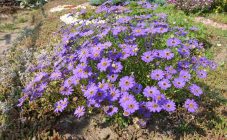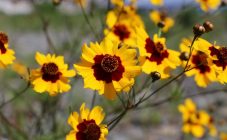Content:
Buzulnik belongs to the genus of perennial herbs of the Astrov family, which includes about 150 plant species common in Eurasia. Due to the shape of the marginal flowers in the inflorescences, it was called ligularia (lat.Ligulária). Some of the buzulnik species are decorative. The regions of East Asia and Southeast Asia are considered to be the natural area of distribution. Most of the buzulniks grows in Southwest China and Central Asia.
Plant characteristic
Buzulnik leaves are heart-shaped or kidney-shaped, grow from a basal rosette. Their width is about 60 cm. They are also finger-separate, toothed with a soft edge along the entire underside of the leaf. The color ranges from green to deep green, saturated. There are greenish-purple and red-brown variants. It happens that the bottom of the leaf is purple, and the top is green with a purple tint.
The flower stalks of the plant are tall, in some specimens they can reach a mark of 2 m. Buzulnik flowers are baskets, the diameter of which reaches 10 cm. They are collected in complex inflorescences and gradually bloom from bottom to top. Flowering occurs most often in summer, it can last 2 months, depending on the variety. The latest species finish blooming at the end of September. The fruit is a small achene with a pappus, a kind of parachute.
Description Buzulnik Przewalski
This plant was named after the famous Russian traveler, honorary member of the Academy of Sciences, Major General N.M. Przhevalsky. In addition to central Russia, it grows well in the Urals. But, nevertheless, Przewalski's buzulnik - whose Chinese name 掌 叶 橐 吾 (zhang ye tuo wu), is most widespread in such regions of China as:
- Inner Mongolia;
- Ningxia;
- Sichuan;
- Shanxi;
- Henan;
- Qinghai and some others.
Buzulnik Przewalski in China is considered a medicinal plant largely due to the roots, which contain antibacterial properties. A well-developed buzulnik bush reaches a height of 1.5 m. The leaves are sharp-fingered with red-brown petioles. The flowers of the ligularia are small, their color is yellow. Inflorescences are spicate, 50–70 cm long, with slightly sagging tops. It blooms at the end of June and ends in the last decade of July. It belongs to the early varieties.
Buzulnik Przewalski: planting and care in the open field
Ligularia can be propagated by dividing the bush or seeds. Particular attention should be paid to the choice of location. The best is the area with fertile soil, located in the shade of trees. If it is alumina, then it must be fertilized with humus. It is good if a stream flows nearby or a small decorative pond or fountain is located.
The ligularia bush under optimal conditions can grow for 20 years.However, every 5 years it is required to rejuvenate it - to divide it into parts and plant the resulting cuttings in wells prepared in advance. Buzulnik is transplanted in autumn no later than mid-September, in this case the plant will be able to take root before the onset of cold weather. This is the so-called vegetative breeding method of the buzulnik.
The rhizome should first be cleaned of dirt and washed, and then cut into several parts with a sharp knife so that a fertile kidney is present in each. Sections are sprinkled with crushed charcoal or disinfected with a manganese solution. The holes should be ready by the time the buzulniks are planted, and have a size of at least 0.4 × 0.4 × 0.4 m. Humus and fertile soil should be put in them, mixed well.
The seed method of growing buzulnik is longer. The bush for landscape decoration will be obtained only after 3-4 years. Ripe seeds are harvested in late August - early September. They are quickly dried and then immediately sown into the soil. Sowing depth - 2 cm. Seeds sown in open ground will sprout in spring. The resulting seedlings can then be planted in a permanent place.
It is recommended immediately after planting to apply mineral fertilizers that are most suitable for the type of soil and its characteristics. Throughout May, you need to feed the plant with an infusion of cow slurry prepared from manure and water in a ratio of 1:10. The norm for 1 adult buzulnik bush is 3-4 liters.
Buzulnik, planting and caring for which does not require special knowledge, is growing quite rapidly. Sufficient moisture is considered one of the most important conditions for its further development. If the bush is located on the shore of a reservoir, it will have enough moisture, and only in the driest period will it be necessary to moisten the leaves with a napkin soaked in water, without leaving drops on the plane of the leaf. They can turn into ruthless lenses in bright sun and damage the entire structure. If the buzulnik grows in the shade, but in a dry place, it needs regular watering, the frequency of which depends on the type of soil. Be sure to mulch with straw or small shavings to reduce evaporation and retain moisture.
In addition to the mullein solution (1:10), which is used at the time of transplantation, every year from May to July, half a bucket of humus must be added under each bush. The best mineral fertilizer is considered to be superphosphate, which is applied at the rate of 40-50 g per 1 m². However, its introduction in liquid form is considered the most effective. This amount is diluted in one bucket of water and poured under one plant at a time.
Diseases and pests
Buzulnik Przewalski usually does not have any special problems with pests. But, if the site is infected with slugs that damage young leaves, then superphosphate granules can be scattered under the bushes to block their access to the stems, and beans, peas, soybeans should be planted throughout the territory for further prevention from pests.
Buzulnik Przewalski in landscape design
Large bushes with deep green carved leaves, sometimes crimson, look quite impressive in various landscape design projects. Therefore, they are actively used in the garden to decorate the territory and flower beds, decorate areas under trees, near small fountains and decorative waterfalls in the areas of country houses and cottages.
Plants near the pond feel cozy, large leaves cast a shadow on the water, thereby creating more suitable conditions for fish and other inhabitants of the reservoir.In addition, there is practically no need to care for the bushes, although you should still constantly monitor their condition. The flowering time and decorative properties of Przewalski's Buzulnik make it an excellent companion for blue-blue delphiniums and dark blue aconites.
In general, Przewalski's buzulnik is the flower that can decorate the most dull and unprepossessing areas. It is easy for them to decorate ugly places and inexpressive slopes. Moreover, even a beginner grower will succeed!














